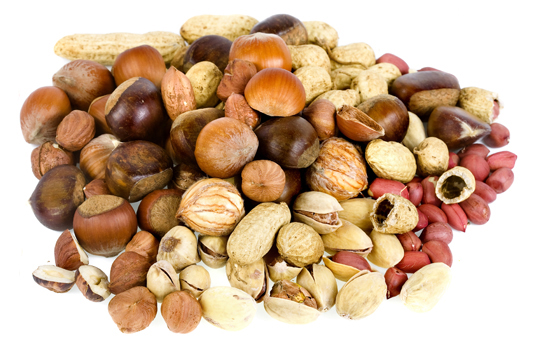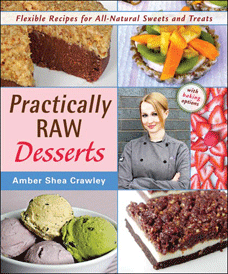 Today’s Friday guest post comes to us from Practically Raw Desserts author Amber Shea Crawley. Amber is a chef and writer specializing in health- and happiness-promoting food. She was classically trained in the art of gourmet living cuisine at the world-renowned Matthew Kenney Academy, graduating in 2010 as a certified raw chef. In 2011, she earned her Nutrition Educator certification at the Living Light Culinary Arts Institute.
Today’s Friday guest post comes to us from Practically Raw Desserts author Amber Shea Crawley. Amber is a chef and writer specializing in health- and happiness-promoting food. She was classically trained in the art of gourmet living cuisine at the world-renowned Matthew Kenney Academy, graduating in 2010 as a certified raw chef. In 2011, she earned her Nutrition Educator certification at the Living Light Culinary Arts Institute.
Nuts and Seeds in Raw Food Desserts
Nuts can be chopped, crushed, blended, or used whole; they can add texture, flavor, crunch, or creaminess to a dish; they can even be turned into milks and flours. All nuts contain good amounts of healthy fats (particularly monounsaturated fat), fiber, protein, and minerals. Many nuts are also a great source of fat-soluble vitamins, particularly vitamin E.
- Almonds: Probably the most all-purpose nut in the raw food world, almonds make beautiful milks, flours, and nut butters, and they’re rich in calcium and vitamin E to boot.
- Brazil nuts: The world’s best source of the trace mineral selenium, which is important for proper thyroid function, just one Brazil nut supplies 100% of the RDA.
- Cashews: Thanks to their beautiful creaminess and slight sweetness, they’re an important component of many raw desserts. They’re also a good source of magnesium, which is vital for healthy muscles and bones.
- Hazelnuts: Also called “filberts,” hazelnuts contain a great deal of folate, an important B vitamin that helps build and repair DNA. They’re super-crunchy and go great with chocolate.
- Macadamia nuts: Macadamias contain more healthful monounsaturated fats and fewer pro-inflammatory omega-6 fats than any other nut. Rich, buttery-tasting macadamias can be used for creaminess in the same way cashews can.
- Pecans: Pecans are one of my favorite nuts in the world for their toasty flavor and rich texture. They also contain more antioxidants than any other nut.
- Pistachios: The lowest-calorie nut, pistachios possess an unmistakable (and lovely) green hue and an addictive crunch.
- Walnuts: More anti-inflammatory, heart-healthy omega-3 essential fatty acids can be found in walnuts than in any other nut.
As with nuts, seeds are a very versatile ingredient. They have a variety of functions in raw desserts, from binding to thickening to replacing tree nuts. Raw seeds also contain plenty of good fats, protein, fiber, and minerals.
- Chia seeds: These unique little seeds, which come in regular (black) and white varieties, are positively packed with omega-3 fats, fiber, and protein. When combined with water, they form a mucilaginous gel, which may sound ugly, but it’s seriously awesome. Chia seeds are fabulous at binding to toxins and scrubbing waste from inside your digestive tract.
- Flaxseeds: Full of plant lignans, omega-3 fatty acids, and fiber, flaxseeds also become gelatinous when ground and soaked. As such, they can be used as a binder in raw recipes. The whole seeds are indigestible and must be ground before eating or using in a recipe.
- Hempseeds: These superseeds have it all: essential fats, dietary fiber, complete protein, and loads of minerals. They’re tiny and nutty-tasting, and I love making them into a nutritious nondairy milk.
- Pumpkin seeds: A great seed to use as a tree-nut replacement, pumpkin seeds (sometimes called “pepitas”) are packed with minerals like zinc and iron.
- Sesame seeds: I most often use these little calcium powerhouses in their ground form, called tahini.
- Sunflower seeds: Full of vitamin E and delicious in their own right, sunflower seeds are my go-to seed for replacing tree nuts when I need to make a recipe nut-free.
From Practically Raw Desserts by Amber Shea Crawley. ©2013 Amber Shea Crawley. Used by permission from Vegan Heritage Press.




